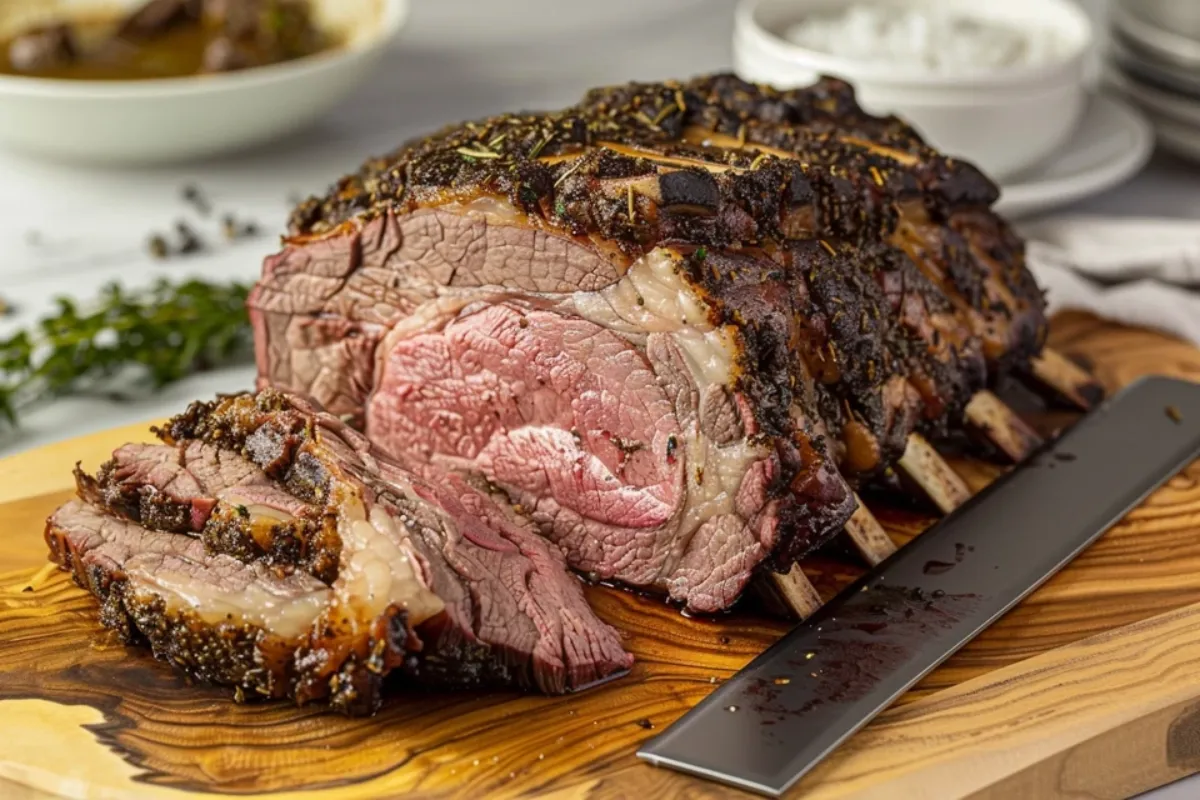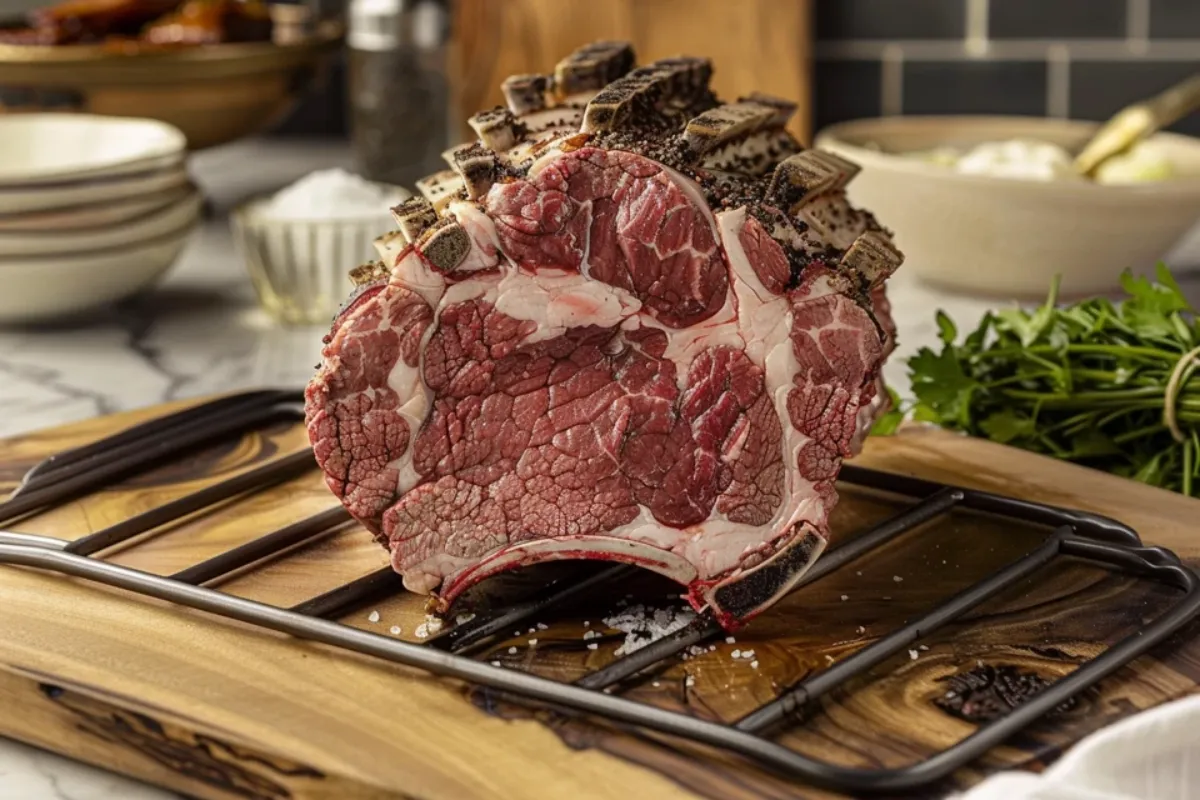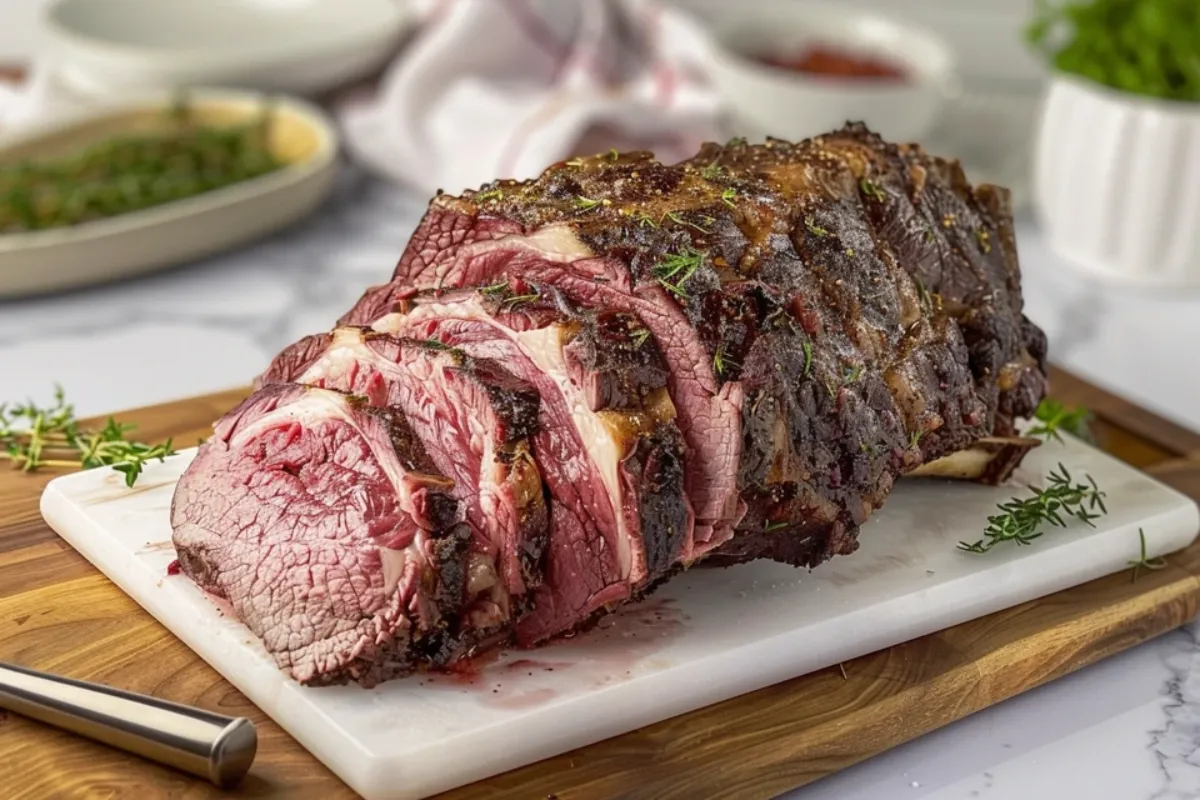A boneless beef rib roast is a luxurious and flavorful cut of meat, perfect for special occasions or a sumptuous Sunday dinner. Its tenderness and rich taste make it a favorite among beef enthusiasts. In this comprehensive guide, we’ll explore everything you need to know to prepare, cook, and serve a perfect boneless beef rib roast.
Table of Contents
ToggleIntroduction
The boneless beef rib roast, also known as a boneless prime rib, is a premium cut from the rib section of the cow. Its rich marbling and tenderness make it ideal for roasting, resulting in a juicy and flavorful centerpiece for any meal. Understanding the nuances of selecting, preparing, and cooking this roast can elevate your culinary skills and impress your guests.
1. Understanding the Boneless Beef Rib Roast
1.1 What is a Boneless Beef Rib Roast?
A boneless beef rib roast is derived from the rib section of the cow, specifically ribs six through twelve. Removing the bones makes it easier to carve and serve, while still retaining the rich flavor and tenderness characteristic of this cut. It’s often referred to as a boneless prime rib or boneless ribeye roast.
1.2 Grades and Quality
Beef is graded based on marbling and maturity. The most common grades are:
- Prime: Abundant marbling, very tender and flavorful.
- Choice: Less marbling than Prime but still high quality.
- Select: Leaner with less marbling, less tender.
For the best experience, opt for a Prime or high-Choice grade boneless beef rib roast.
2. Selecting the Perfect Roast
2.1 Determining the Size
Estimate about one pound of uncooked roast per person. This accounts for shrinkage during cooking and ensures generous portions. For example, a 5-pound roast should serve approximately five people.
2.2 Evaluating Marbling
Marbling refers to the white flecks of fat within the muscle. More marbling generally means more flavor and juiciness. Look for a roast with even distribution of marbling throughout the meat.
3. Preparing the Roast
3.1 Bringing to Room Temperature
Remove the roast from the refrigerator about two hours before cooking. Allowing it to come to room temperature ensures even cooking.
3.2 Seasoning
A simple seasoning allows the natural flavors to shine:
- Salt: Use kosher or sea salt to season all sides generously.
- Pepper: Freshly ground black pepper adds a subtle heat.
- Optional Herbs: Rosemary, thyme, and garlic can enhance the flavor profile.
Apply the seasoning at least an hour before cooking to allow it to penetrate the meat.
4. Cooking Methods
4.1 Traditional Oven Roasting
This classic method yields a tender and juicy roast.
Steps:
- Preheat the Oven: Set to 450°F (232°C).
- Initial Sear: Place the roast fat-side up on a rack in a roasting pan. Roast for 15 minutes to develop a crust.
- Reduce Temperature: Lower the oven to 325°F (163°C) and continue roasting.
- Monitor Temperature: Use a meat thermometer to check internal temperature:
- Rare: 120°F (49°C)
- Medium-Rare: 130°F (54°C)
- Medium: 140°F (60°C)
- Rest the Meat: Remove from oven and tent with foil. Let it rest for 15-20 minutes before carving.
4.2 Reverse Searing
This technique involves slow roasting followed by a high-temperature sear.
Steps:
- Preheat the Oven: Set to 250°F (121°C).
- Slow Roast: Place the seasoned roast on a rack in a roasting pan. Roast until internal temperature is 10°F (6°C) below desired doneness.
- Rest: Remove from oven and let it rest for 20 minutes.
- Sear: Increase oven temperature to 500°F (260°C). Return the roast to the oven for 10-15 minutes to develop a crust.
- Final Rest: Let the roast rest again for 10 minutes before carving.
4.3 Grilling
Grilling imparts a smoky flavor to the roast.
Steps:
- Prepare the Grill: Set up for indirect heat, aiming for a temperature of 325°F (163°C).
- Grill the Roast: Place the roast on the cooler side of the grill, fat-side up. Cover and cook, maintaining consistent temperature.
- Monitor Temperature: Use a meat thermometer to achieve desired doneness.
- Sear (Optional): For a crust, move the roast to the direct heat side for a few minutes per side.
- Rest: Remove from grill and let it rest for 15-20 minutes before carving.
5. Determining Doneness
Using a meat thermometer is the most accurate way to determine doneness.
| Doneness | Internal Temperature | Description |
|---|---|---|
| Rare | 120°F (49°C) | Cool red center |
| Medium-Rare | 130°F (54°C) | Warm red center |
| Medium | 140°F (60°C) | Warm pink center |
| Medium-Well | 150°F (66°C) | Slightly pink center |
| Well-Done | 160°F (71°C) | Little to no pink |
Remember, the roast’s internal temperature will rise by 5-10°F (3-6°C) during resting, so it’s essential to remove it from the oven or grill before reaching the final desired temperature. This ensures perfect doneness without overcooking.
6. Tips for the Perfect Boneless Beef Rib Roast
6.1 Use a Meat Thermometer
A reliable meat thermometer is a must-have tool for ensuring your boneless beef rib roast is cooked to perfection. Insert the thermometer into the thickest part of the roast, avoiding any fat or bones for an accurate reading.
6.2 Allow Adequate Resting Time
Resting the roast after cooking is crucial to let the juices redistribute evenly throughout the meat. Cover the roast loosely with foil and let it rest for at least 15-20 minutes.
6.3 Choose the Right Pan
Use a roasting pan with a rack to elevate the roast. This ensures even heat circulation and prevents the bottom from becoming soggy.
6.4 Enhance Flavor with Compound Butter
For an extra touch of indulgence, spread a layer of herb-infused compound butter over the roast during the final few minutes of cooking. This enhances the crust and adds a burst of flavor.
7. Side Dishes to Complement the Roast
7.1 Classic Side Dishes
- Mashed Potatoes: Creamy and buttery, they pair perfectly with the rich flavors of the roast.
- Yorkshire Pudding: A traditional side for roasts, these light and fluffy pastries are ideal for soaking up juices.
- Green Beans Almondine: A simple yet elegant vegetable side dish.
7.2 Sauce Options
- Red Wine Jus: A reduction of red wine and beef stock adds depth and elegance.
- Horseradish Sauce: A zesty, creamy accompaniment that complements the richness of the beef.
- Mushroom Gravy: Earthy and savory, it pairs beautifully with the roast.
7.3 Seasonal Variations
For a holiday meal, consider pairing the roast with cranberry sauce, roasted root vegetables, or spiced sweet potatoes.
8. Storing and Reheating Leftovers
8.1 Proper Storage
Store leftover boneless beef rib roast in an airtight container in the refrigerator for up to 3-4 days. For longer storage, wrap the roast tightly in aluminum foil and place it in the freezer, where it can last up to three months.
8.2 Reheating Tips
To retain moisture and flavor, reheat the roast gently:
- In the Oven: Preheat the oven to 250°F (121°C). Place the roast in a baking dish with a splash of beef broth, cover with foil, and heat until warmed through.
- On the Stovetop: Slice the roast into portions and warm them in a skillet over low heat with a bit of butter or beef broth.
8.3 Creative Leftover Ideas
- Beef Sandwiches: Thinly sliced roast with horseradish sauce on a crusty baguette.
- Beef Stir-Fry: Toss chunks of roast with vegetables and soy-based sauce for a quick meal.
- Beef and Barley Soup: Use diced roast in a hearty soup with barley and vegetables.
9. Troubleshooting Common Issues
9.1 Overcooked Roast
If the roast is overcooked, slice it thinly and serve it with a generous amount of sauce to add moisture.
9.2 Undercooked Roast
If the roast is undercooked, return it to the oven or grill for a few minutes until it reaches the desired temperature.
9.3 Uneven Cooking
Allow the roast to come to room temperature before cooking, and use a thermometer to ensure even doneness throughout.
10. Nutritional Information and Health Tips
10.1 Nutritional Profile of Boneless Beef Rib Roast
A boneless beef rib roast is not only delicious but also packed with essential nutrients. Here’s a breakdown of its nutritional content per 3-ounce serving (approximately 85 grams):
| Nutrient | Amount | Daily Value (%) |
|---|---|---|
| Calories | 250 | – |
| Protein | 23 g | 46% |
| Total Fat | 17 g | 26% |
| Saturated Fat | 7 g | 35% |
| Cholesterol | 70 mg | 23% |
| Iron | 2.2 mg | 12% |
| Zinc | 4.5 mg | 30% |
| Vitamin B12 | 2.4 mcg | 100% |
Boneless beef rib roast is a good source of protein, iron, and zinc, which are vital for energy production, immune function, and overall health. However, it’s also relatively high in saturated fat, so moderation is key for a balanced diet.
10.2 Health Tips for Enjoying Boneless Beef Rib Roast
- Trim Excess Fat: Before cooking, trim visible fat to reduce saturated fat content.
- Portion Control: Stick to recommended serving sizes to avoid overindulgence.
- Pair with Vegetables: Balance the richness of the roast with fiber-rich vegetables for a complete meal.
- Choose Heart-Healthy Sides: Incorporate whole grains and healthy fats, like olive oil or avocado, to round out your meal.
11. Expert Tips for Perfecting Your Roast
11.1 Choosing Fresh Ingredients
- Fresh Herbs: Opt for fresh rosemary, thyme, and garlic for the best flavor.
- High-Quality Meat: Purchase from a trusted butcher or a reputable supermarket to ensure freshness.
11.2 Enhancing Flavor
- Dry-Aging: If possible, dry-age the roast in your refrigerator for a few days before cooking. This process concentrates flavor and improves tenderness.
- Marinades and Rubs: For added flavor, marinate the roast in a mixture of olive oil, garlic, and herbs overnight.
11.3 Presentation Matters
- Slice the roast against the grain for maximum tenderness.
- Arrange slices on a warm platter and garnish with fresh herbs for a restaurant-quality presentation.
12. Seasonal and Regional Variations
12.1 Seasonal Flavors
- Winter: Pair the roast with roasted root vegetables, chestnuts, or a cranberry glaze.
- Spring: Use fresh herbs like mint and parsley, and serve with a side of asparagus or peas.
- Summer: Incorporate grilled vegetables and a light citrus-based sauce.
- Fall: Embrace earthy flavors like mushrooms, pumpkin puree, or a red wine reduction.
12.2 Regional Twists
- American BBQ Style: Rub the roast with a smoky barbecue seasoning and slow-cook it.
- French Style: Serve with béarnaise sauce or gratin dauphinois.
- Asian-Inspired: Marinate the roast in soy sauce, ginger, and garlic, then serve with stir-fried vegetables.
13. Hosting Tips for Serving Boneless Beef Rib Roast
13.1 Planning the Meal
- Appetizers: Start with light appetizers like a salad, shrimp cocktail, or charcuterie board.
- Drinks: Pair the roast with bold red wines like Cabernet Sauvignon or a full-bodied Malbec.
- Desserts: Finish the meal with a light dessert, such as fruit sorbet or a flourless chocolate cake.
13.2 Table Presentation
- Use elegant serving dishes and carve the roast tableside for a dramatic presentation.
- Provide guests with high-quality steak knives to ensure easy cutting.
13.3 Keeping it Warm
If the roast is ready before serving, keep it warm by placing it in a low-temperature oven (around 200°F or 93°C) covered loosely with foil.
Conclusion
Preparing a boneless beef rib roast is a true culinary adventure, perfect for impressing your guests or enjoying a memorable meal. This luxurious cut of meat, with its tenderness and rich flavors, offers endless possibilities, whether you choose traditional oven roasting, grilling, or the reverse-searing method. By following the detailed steps for selecting, preparing, and cooking, you can ensure a dish that rises to the occasion. Remember, the key to success lies in choosing high-quality ingredients, using a meat thermometer for precise cooking, and allowing adequate resting time for optimal juiciness. Paired with flavorful sides and thoughtfully prepared sauces, your roast is sure to become the centerpiece of any festive gathering. Enjoy!
FAQ:
1. Is boneless rib roast the same as prime rib?
No, a boneless rib roast and prime rib are not exactly the same, although they are closely related.
- Prime rib refers to a specific cut of beef taken from the primal rib section, which includes the ribeye and is traditionally served with the bone in. It is often cooked using a “standing rib roast” method where the roast is left on the bone and cooked slowly for maximum flavor and tenderness.
- A boneless rib roast is essentially a prime rib with the bone removed. While the flavor is similar, the presentation and cooking method differ slightly due to the absence of the bone, which can affect the way heat distributes through the meat.
Both cuts are well-marbled, tender, and flavorful, making them excellent choices for special occasions or festive meals.
2. What temperature should a boneless rib roast be cooked at?
The ideal temperature for cooking a boneless rib roast depends on the desired level of doneness. Here are general guidelines:
- Preheat oven to 450°F (232°C): Start the roast at this high temperature for about 15-20 minutes to sear the outside and lock in juices.
- Reduce the oven temperature to 325°F (163°C): Continue cooking until the internal temperature reaches your desired doneness. Use a meat thermometer to check for accuracy.
Internal temperature targets for doneness:
- Rare: 120–125°F (49–52°C)
- Medium Rare: 130–135°F (54–57°C)
- Medium: 140–145°F (60–63°C)
- Well Done: 150°F (66°C) and above
Allow the roast to rest for at least 15-20 minutes after removing it from the oven. During this time, the internal temperature will rise by 5-10°F, and the juices will redistribute.
3. Is beef rib roast the same as short ribs?
No, a beef rib roast and short ribs are not the same.
- Beef rib roast comes from the rib primal section and is a large, tender cut of meat that is often roasted whole. It includes the ribeye and is known for its rich marbling and flavor. This cut is best suited for roasting or slow cooking.
- Short ribs come from the lower part of the rib section, closer to the belly. They are smaller, more marbled, and have a higher fat content. Short ribs are best cooked using slow, moist-heat methods such as braising to make them tender.
In summary, the rib roast is a large, tender cut suitable for roasting, while short ribs are tougher and better suited for slow cooking.
4. How to cook boneless prime rib per pound chart?
The cooking time for boneless prime rib depends on the weight of the roast and your desired doneness. Below is a per-pound guide for roasting boneless prime rib at 325°F (163°C) after the initial sear at 450°F (232°C):
Cooking Times Per Pound
| Doneness | Internal Temp | Cooking Time (minutes per pound) |
|---|---|---|
| Rare | 120–125°F (49–52°C) | 11–12 minutes |
| Medium Rare | 130–135°F (54–57°C) | 13–14 minutes |
| Medium | 140–145°F (60–63°C) | 15–16 minutes |
| Well Done | 150°F+ (66°C+) | 18–20 minutes |
Steps to Cook Boneless Prime Rib
- Preparation:
- Let the roast sit at room temperature for 1-2 hours before cooking.
- Season generously with salt, pepper, garlic, and herbs.
- Sear: Preheat the oven to 450°F (232°C) and cook the roast for 15-20 minutes to develop a crust.
- Roast: Lower the temperature to 325°F (163°C) and continue cooking based on the per-pound chart above.
- Rest: Remove the roast from the oven, tent with foil, and let it rest for 15-20 minutes before slicing.
Example for a 6-pound roast cooked to medium rare:
- Initial Sear: 450°F for 20 minutes
- Roast Time: 6 pounds × 14 minutes = ~84 minutes (1 hour and 24 minutes)
- Total Time: ~1 hour 44 minutes, plus resting time.


